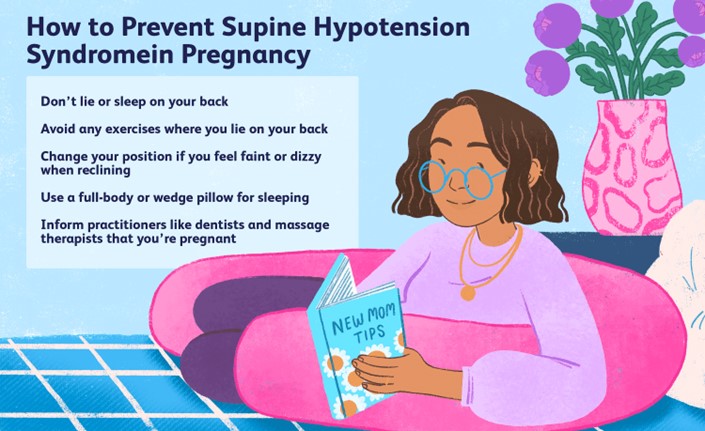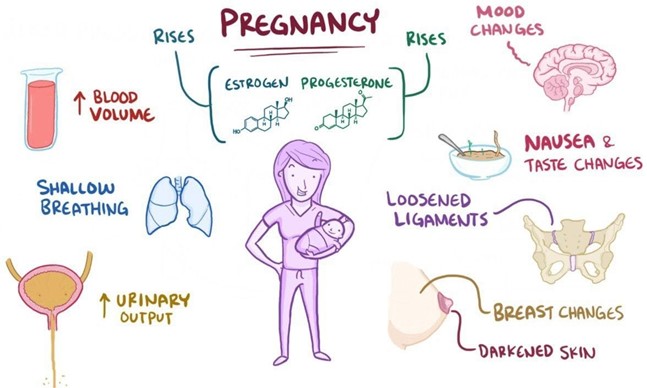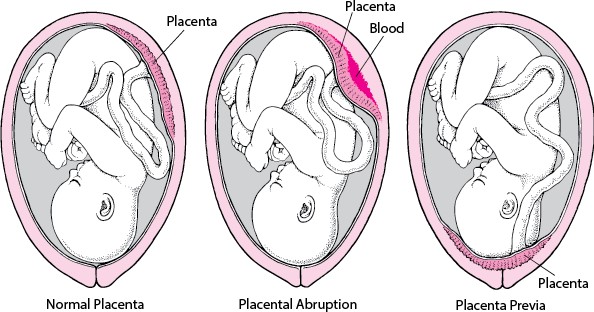In a client's seventh month of pregnancy, she reports feeling "dizzy, like I'm going to pass out, when I lie down flat on my back". The nurse explains that this is due to:
Select one:
Physiologic anemia due to maternal increased plasma volume.
Pressure of the gravid uterus on the maternal inferior vena cava and aorta.
Pressure of the presenting fetal part on the maternal diaphragm.
A 50% increase in maternal blood volume during pregnancy.
The Correct Answer is B
Choice A Reason: Physiologic anemia due to maternal increased plasma volume. This is an incorrect answer that refers to a different condition that affects hemoglobin levels, not blood pressure. Physiologic anemia is a condition where the maternal plasma volume increases more than the red blood cell mass during pregnancy, which dilutes the hemoglobin concentration and lowers the hematocrit value. Physiologic anemia does not cause significant symptoms or complications in pregnant women, as it is an adaptive mechanism that enhances oxygen delivery and prevents fluid overload.
Choice B Reason: Pressure of the gravid uterus on the maternal inferior vena cava and aorta. This is because this statement explains the cause of supine hypotensive syndrome, which is a condition where lying flat on the back causes compression of the major blood vessels by the gravid uterus, which reduces venous return and cardiac output, which lowers blood pressure and perfusion to vital organs. Supine hypotensive syndrome can cause symptoms such as dizziness, lightheadedness, nausea, pallor, or syncope in pregnant women, especially in the third trimester.
Choice C Reason: Pressure of the presenting fetal part on the maternal diaphragm. This is an incorrect answer that indicates a different condition that affects respiratory function, not blood pressure. Pressure of the presenting fetal part on the maternal diaphragm is a result of cephalic engagement or lightening, which occurs when the fetal head descends into the pelvis and occupies more space in the abdominal cavity. Pressure of the presenting fetal part on the maternal diaphragm can cause symptoms such as dyspnea, heartburn, or rib pain in pregnant women.
Choice D Reason: A 50% increase in maternal blood volume during pregnancy. This is an incorrect answer that describes a normal physiological change that occurs during pregnancy, not a cause of supine hypotensive syndrome. A 50% increase in maternal blood volume during pregnancy is due to increased production of plasma and red blood cells, which helps meet the increased oxygen and nutrient demands of the fetus and placenta, and prepares the mother for blood loss during delivery. A 50% increase in maternal blood volume during pregnancy does not cause hypotension or dizziness in pregnant women.

Nursing Test Bank
Naxlex Comprehensive Predictor Exams
Related Questions
Correct Answer is C
Explanation
Choice A Reason: Homans' sign. This is an incorrect answer that refers to a different sign that is not related to pregnancy. Homans' sign is a sign of deep vein thrombosis (DVT) that occurs when there is pain or discomfort in the calf or popliteal region when the foot is dorsiflexed. Homans' sign can be elicited by passive or active movement of the foot, but it is not a reliable or specific indicator of DVT.
Choice B Reason: Chadwick's sign. This is an incorrect answer that refers to a different sign of pregnancy that affects the color of the cervix, not the texture. Chadwick's sign is a sign of pregnancy that refers to the bluish or purplish discoloration of the cervix, vagina, and vulva due to increased blood flow and congestion. Chadwick's sign can be observed by visual inspection of the cervix during the first prenatal visit, usually around 6 to 8 weeks of gestation.
Choice C Reason: Goodell's sign. This is because Goodell's sign is a sign of pregnancy that refers to the softening of the cervix due to increased vascularity and edema. Goodell's sign can be detected by digital examination of the cervix during the first prenatal visit, usually around 6 to 8 weeks of gestation.
Choice D Reason: McDonald's sign. This is an incorrect answer that refers to a different sign of pregnancy that involves the angle of the uterus, not the cervix. McDonald's sign is a sign of pregnancy that refers to the ease of flexing the body of the uterus against the cervix, which creates an angle of 90 degrees or less. McDonald's sign can be assessed by bimanual examination of the uterus during the first prenatal visit, usually around 7 to 8 weeks of gestation.

Correct Answer is B
Explanation
Choice A Reason: Shoulder dystocia. This is an incorrect answer that describes a different obstetric complication. Shoulder dystocia is a condition where the baby's shoulder gets stuck behind the mother's pubic bone during delivery, which can cause nerve injury, fracture, or asphyxia to the baby. Shoulder dystocia does not cause fetal bradycardia, abdominal pain, or vaginal bleeding.
Choice B Reason: Placental abruption. This is a correct answer that explains the symptoms of fetal bradycardia, abdominal pain, and vaginal bleeding in a woman with a history of crack cocaine use. Placental abruption. This is because placental abruption is a condition where the placenta separates from the uterine wall before delivery, which can cause fetal distress, maternal hemorrhage, and shock. Placental abruption can be triggered by maternal hypertension, trauma, or substance abuse, such as crack cocaine.
Choice C Reason: Anaphylactoid syndrome of pregnancy. This is an incorrect answer that refers to a rare and fatal condition also known as amniotic fluid embolism. Anaphylactoid syndrome of pregnancy is a condition where amniotic fluid enters into the maternal bloodstream and causes an allergic reaction, which can lead to respiratory failure, cardiac arrest, coagulopathy, and coma. Anaphylactoid syndrome of pregnancy does not cause fetal bradycardia or vaginal bleeding.
Choice D Reason: Placenta previa. This is an incorrect answer that indicates another placental disorder. Placenta previa is a condition where the placenta covers or is near the cervix, which can cause painless bright red bleeding during pregnancy or labor. Placenta previa does not cause fetal bradycardia or abdominal pain.

Whether you are a student looking to ace your exams or a practicing nurse seeking to enhance your expertise , our nursing education contents will empower you with the confidence and competence to make a difference in the lives of patients and become a respected leader in the healthcare field.
Visit Naxlex, invest in your future and unlock endless possibilities with our unparalleled nursing education contents today
Report Wrong Answer on the Current Question
Do you disagree with the answer? If yes, what is your expected answer? Explain.
Kindly be descriptive with the issue you are facing.
